Are you concerned about protecting your skin from the damaging effects of the sun? Skin cancer is one of the most common types of cancer, but the good news is that it is also one of the most preventable. In this article, we will discuss effective strategies for shielding your skin from harmful UV rays and reducing your risk of developing skin cancer. From using sunscreen to wearing protective clothing, we will explore a range of practical tips that will not only keep your skin healthy but also help you maintain a glowing complexion.
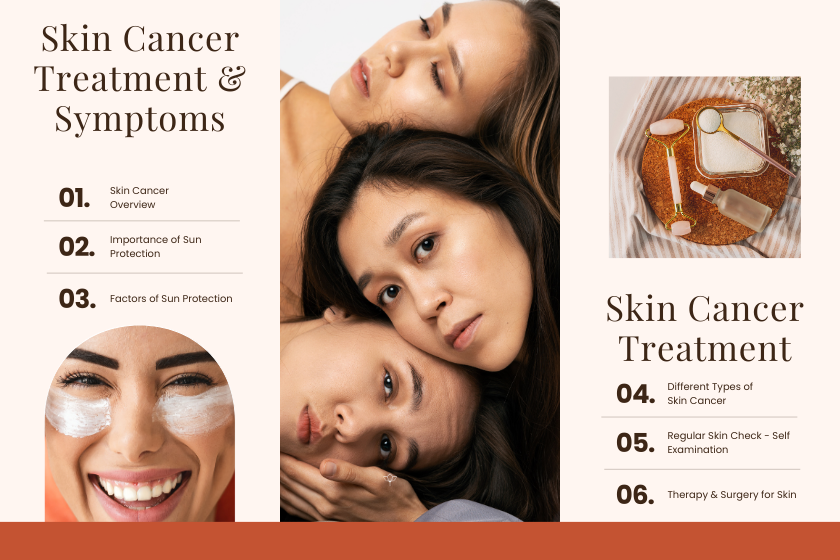
Skin Cancer Overview
Skin cancer is a condition that occurs when abnormal cells in the skin grow uncontrollably. It is primarily caused by exposure to ultraviolet (UV) radiation from the sun or tanning beds. There are three main types of skin cancer: basal cell carcinoma, squamous cell carcinoma, and melanoma. Basal cell carcinoma and squamous cell carcinoma are the most common types and are usually less aggressive than melanoma. However, melanoma is the most dangerous form of skin cancer and can spread to other parts of the body if not detected and treated early.
It is important to understand the risk factors associated with skin cancer. Fair-skinned individuals, people with a family history of skin cancer, and those with a weakened immune system are at a higher risk. Additionally, excessive exposure to UV radiation, especially during childhood, increases the likelihood of developing skin cancer later in life. While it may seem daunting, there are numerous ways to protect your skin and reduce your risk of developing skin cancer.
Importance of Sun Protection:
Sun protection is crucial for maintaining healthy skin and preventing skin cancer. UV radiation from the sun can damage the DNA in skin cells, leading to mutations that can result in cancerous growths. Furthermore, prolonged exposure to the sun’s rays can cause premature aging, wrinkles, and sunspots. By incorporating sun protection into your daily routine, you can minimize the damaging effects of the sun and maintain a youthful appearance.
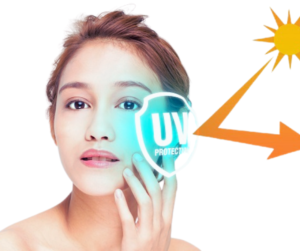
To effectively protect your skin from the sun, it is important to follow a few key tips. Firstly, make sunscreen a daily habit by applying it 30 minutes before sun exposure. This allows the ingredients to fully absorb into the skin and provide maximum protection.
Secondly, don’t be fooled by cloudy or overcast days. UV rays can still penetrate through clouds, so sunscreen is necessary even when the sun isn’t shining brightly. Thirdly, be mindful of reflective surfaces such as water, sand, and snow, as they can intensify the sun’s rays and increase your risk of sunburn. Lastly, remember to protect commonly overlooked areas such as the lips, ears, and the back of the neck, as these areas are particularly vulnerable to sun damage.
Skin Cancer Types
- Basal Cell Carcinoma (BCC) is the most common type of skin cancer. It often appears as a flesh-colored, pearl-like bump or a pinkish patch of skin.
- Squamous Cell Carcinoma (SCC) is the second most common type of skin cancer. It often presents as a red, firm bump, scaly patch, or a sore that heals and then re-opens.
- Actinic Keratoses (AKs) are dry, scaly patches or spots that are precancerous growths. Although not skin cancer themselves, they can turn into SCC.
- Melanoma is the deadliest form of skin cancer. It frequently develops in a mole or suddenly appears as a new dark spot on the skin.
Skin Cancer Symptoms and Signs
It is important to be aware skin cancer symptoms and signs so that you can detect any changes in your skin early.
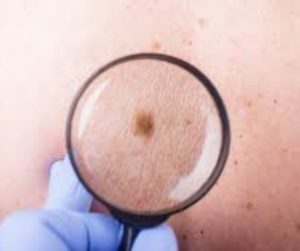
The ABCDE rule is a useful guide for identifying potential warning signs of melanoma. A stands for asymmetry, meaning one half of a mole or birthmark is different from the other half. B stands for border irregularity, where the edges of a mole are not smooth but rather have irregular or jagged borders. C stands for color variation, as melanomas often have multiple colors or shades within the same mole. D stands for diameter, where a mole larger than 6 millimeters in diameter may be a cause for concern. E stands for evolving, which means that if a mole or spot on the skin is changing in size, shape, or color, it should be examined by a dermatologist.
- Basal Cell Carcinoma (BCC) often appears as a flesh-colored bump or pinkish patch. It’s rarely lethal but can cause disfigurement.
- Squamous Cell Carcinoma (SCC) presents as a red, firm bump or scaly patch. Early treatment is essential to prevent damage.
- Melanoma the deadliest type, often arising from moles or new dark spots. Regular skin checks are crucial for early detection.
Basal Cell Carcinoma (BCC) Skin Cancer Symptoms
Basal cell carcinoma (BCC) is a type of skin cancer that often appears as a shiny, translucent bump or a brown, black, or blue lesion. It can also manifest as a flat, scaly patch with a raised edge.
Learn more: 10 Warning Symptoms of Basal Cell Skin Cancer
- Rough, dry, or scaly patches, usually less than 1 inch in diameter.
- Flat to slightly raised patches or bumps on the skin.
- Color variations (pink, red, or brown).
- Itching, burning, bleeding, or crusting.
Melanoma Skin Cancer Symptoms
- New or Changing Spots on the Skin
- ABCDE Rule for Melanoma
Skin Cancer Prevention Strategies
Alongside sun protection measures, there are additional strategies you can adopt to further reduce your risk of developing skin cancer. Firstly, avoid indoor tanning beds, as they emit harmful UV radiation that can significantly increase your risk of developing skin cancer. Secondly, be cautious of medications that may increase your skin’s sensitivity to the sun.
Certain antibiotics, antidepressants, and acne medications can make your skin more susceptible to sunburn. Consult with your healthcare provider to determine if any of your medications have this side effect. Lastly, lead a healthy lifestyle by eating a balanced diet, exercising regularly, and not smoking. These lifestyle factors can contribute to overall skin health and reduce your risk of various types of cancer, including skin cancer.
Skin Cancer Consultants in Pakistan
Regular Skin Checks and Self-Examinations
Performing regular skin checks and self-examinations can help you detect any changes or abnormalities in your skin early on. Conduct a thorough examination of your skin every month, looking for any new moles or growths, changes in the size or appearance of existing moles, or any other irregularities. In addition, it is recommended to visit a dermatologist for a professional skin examination at least once a year. A dermatologist can identify any potential signs of skin cancer that may not be easily detectable to the untrained eye. Early detection is key to successful treatment, so be vigilant and proactive in monitoring your skin.
Skin Cancer Treatment
There are the several options for skin cancer treatment. Here’s some treatment options. Be sure to consult a skin’s doctor doing skin cancer treatment.
Learn more skin cancer treatment from National Cancer Institute
Surgery: Surgery involves removing the cancerous tissue. The type of surgery depends on the cancer’s size, location, and type. Here four types of surgery about skin cancer.
- Excisional Surgery The tumor is cut out along with some healthy tissue around it.
- Mohs Surgery Layer-by-layer removal, especially for high-risk areas or recurrent tumors.
- Cryosurgery Freezing the tumor using liquid nitrogen.
- Curettage and Electrodesiccation Scraping off the tumor and using an electric current to destroy remaining cancer cells.
Radiation Therapy High-energy rays target cancer cells, damaging their DNA and preventing growth. Radiation is an option for patients who can’t undergo surgery or have certain types of skin cancer. Radiation therapy have two types one is External Beam Radiation and other one is Brachytherapy. But, keep in mind radiation therapy have side effects issues like skin changes, fatigue, and localized hair loss. You may need to consult with skin care specialist before.
Topical Medications Creams or gels containing drugs (like imiquimod or 5-fluorouracil) are applied directly to the skin. For superficial basal cell carcinomas or actinic keratoses.
Immunotherapy Boosts the immune system to fight cancer cells. For advanced melanoma or squamous cell carcinoma.
Targeted Therapy Targets specific molecules involved in cancer growth. For advanced melanoma with specific genetic mutations.
Skin Cancer Images
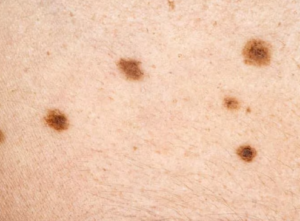
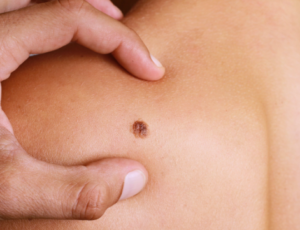
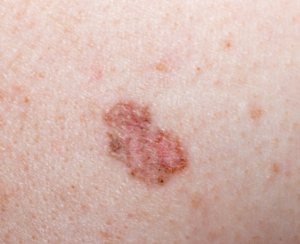
Conclusion: Taking Care of Your Skin for a Lifetime
Protecting your skin from the damaging effects of the sun is not just about preventing skin cancer but also about maintaining a healthy and radiant complexion. By understanding the risk factors associated with skin cancer and implementing effective sun protection strategies, you can significantly reduce your risk of developing this potentially life-threatening condition.
Remember to make sunscreen a daily habit, wear protective clothing, seek shade, and be vigilant in monitoring your skin for any changes. By taking care of your skin and making sun protection a priority, you can enjoy the outdoors while keeping your skin safe and glowing for a lifetime.
That’s very informative
This is very informative and helpful. I found the natural way treatement from this.
Thanks